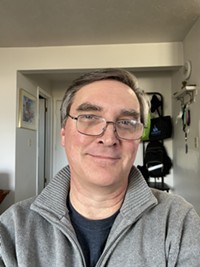Great Salt Lake Fringe Festival 10th anniversary
Celebrating a decade of maintaining a core mission and bringing in new blood.
By Scott Renshaw @scottrenshawWhen you call yourself a "fringe" festival—like, say, calling yourself "alternative" media—it's a way of setting yourself in contrast to certain institutions. But what happens when you've shown enough staying power to become an institution in your own right? What evolves and what remains part of your core mission?
It's been 10 years since the launch of the Great Salt Lake Fringe Festival, building on a fringe festival tradition dating back more than 75 years. And over that time, according to festival co-director and founder Shianne Gray, GSL Fringe has carved out its own identity within that tradition.
"What's really common with fringe festivals is they adapt to their settings and circumstances," Gray says. "Different fringes will have different focuses based on what the place wants to see more of. We tend to be a very local festival compared to other places; we have a lot of local artists who want to produce their own work, and this is an opportunity to do that. ... In the first few years, we would get artists who had done work at other fringes, and then brought it here. Now, we have a large contingent that's come out of this [festival] of artists that have done this for years and years."
As a result, many of the participants, as the saying goes, understand the assignment: keeping the shows under an hour in length and limited in terms of set and technical requirements, to accommodate the reality of multiple shows taking place in each small venue. Nevertheless, the logistics of wrangling more than 20 individual productions makes for an adventure every year.
"It's a fine circus to juggle," says GSL Fringe technical manager Jax Jackman. "I've been a stage manager for almost 20 years, so for me, a fringe festival kind of challenges my skills, but is a really rewarding kind of gig, because of all that juggling. ... The challenge is, we don't see the shows until the festival starts. We encourage them to allow the time for live theater to be live theater, but ... there's this much wiggle room, and that's it."
"It's a really fascinating process," adds volunteer coordinator Jack Cobabe, "to watch the turnover between two different shows. The audience needs to go out, all props and costumes, in 15 minutes, so there's 15 minutes for the next show to load in."
While there are a few such limitations on the length and scale of GSL Fringe shows, the festival is otherwise an open opportunity for artists to show their work. No judging or curating takes place when someone applies; if there's enough physical space, and room on the schedule, you're in. And as a result, it can be an amazing opportunity for those who might not otherwise have a place to find an audience.
"I've always seen fringe to be ... I don't know if accessible is the right word, but if they don't have access to a whole company with funds—it might just be them and their art—they can really self-produce it," Cobabe says. "I think it's a very good way for artists to come and get their work produced, regardless of their backgrounds."
Nevertheless, the festival's staff believes there's always room to do better and be better, especially when it comes to inviting aspiring artists into the process.
"I would say that we could always do better in terms of reaching out to artists, because it is a little daunting putting on something on your own," Jackman notes. "For example, we realized there was a major gap finding connection with the local university theater departments. We're a fringe theater festival, yet many of these students don't know we exist. [Festival co-director Jay Perry] and I showed up at some department meetings, and said, 'Ask us anything.' Seeing that spark of inspiration, I could see was very effective. That's a great example of what Fringe is capable of throughout the year, and not just when we have our festival: 'Here is everything you need to know about creating a fringe show.'"
As much as the festival is for the artists, it's also important to welcome in the audience—which can be challenging, since the very title of a "fringe" festival can make some potential viewers unsure about what they're in for. Yet Shianne Gray emphasizes that even though the content of some of these shows might be a bit unconventional, it's a festival meant to welcome audiences in.
"Our goal for audiences is that they are comfortable and feel welcome," Gray says. "These are very casual spaces, there is no dress code, you come as you are. It's also, we hope, accessible from a financial standpoint compared to other performing arts—for less than you can pay for a touring Broadway show, you can see 10 different shows. It's really about seeing the variety—everything from a hard-hitting drama to a funny burlesque musical in the same venue."
More by Scott Renshaw
-
Film Reviews: New Releases for March 28
A Working Man, The Woman in the Yard, The Penguin Lessons, Death of a Unicorn, Audrey's Children
- Mar 27, 2025
-
Film reviews: THE PENGUIN LESSONS, DEATH OF A UNICORN
Fumbling the potential-filled question of what to do when confronted with a broken system
- Mar 26, 2025
-
Theater preview: Plan-B Theatre Company's The Beatrix Potter Defense Society
Local playwright Janine Sobeck Knighton explores how isolation inspired the beloved author.
- Mar 26, 2025
- More »




